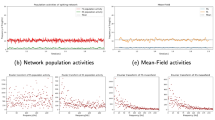Abstract
The aims of this study were to investigate thedetectability of the propagation of the gastric slowwave from the cutaneous electrogastrogram (EGG) and thepatterns of the EGG when the gastric slow waves are uncoupled. A mathematical model wasestablished based on the volume conductor theory tosimulate the transfer of the serosal gastric slow wavefrom the stomach to the abdominal surface. A number of computer simulations were conducted using themodel, and the periodic cross-correlation function wasused to estimate the phase shift between the fourchannels. It was found that the propagation of the gastric slow wave was detectable from themultichannel EGG signals. The detectability of thepropagation was, however, associated with a number offactors, such as the thickness of the abdominal wall and the propagation velocity of the serosal slowwave. The amplitude of the EGG was found to beassociated with the coupling/uncoupling and propagationvelocity of the gastric slow wave. The amplitude of the EGG increased when the propagation velocity ofthe gastric slow wave increased. The amplitude of theEGG was substantially decreased when the gastric slowwaves were uncoupled. The uncoupling of the gastric slow wave at a frequency of 3 cpm produceddysrhythmias in the EGG, including tachygastria,bradygastria, and arrhythmia. The power spectra ofsimulated different positional EGG signals showedsimilar patterns when the gastric slow wave was coupled anddifferent and unpredictable patterns when the gastricslow wave was uncoupled. In conclusion, multichannel EGGrecordings may be necessary to obtain more information on gastric slow waves from the abdominalelectrodes. The propagation and coupling or uncouplingof the gastric slow wave may be detected frommultichannel EGG recordings.
Similar content being viewed by others
REFERENCES
Alvarez WC: The electrogastrogram and what it shows. JAMA 78:1116–1118, 1992
Abell TL, Malagelada J-R: Electrogastrography: Current assessments and future perspective. Dig Dis Sci 83:806–811, 1988
Chen J, Pan J, McCallum R W: Clinical significance of gastric myoelectrical dysrhythmias. Dig Dis 13:275–290, 1995
Chen J, McCallum R W: Clinical applications of electrogastrogram. Am J Gastroenterol 88:1324–1336, 1993
Dubois A: Gastric dysrhythmias: Pathophysiological and etiologic factors. Mayo Clin Proc 64:246–250, 1989
Geldof H, van der Schee EJ, Van Blankenstein M, Grashius JL: Electrogastrographic study of gastric myoelectrical activity in patients with unexplained nausea and vomiting. Gut 26:799–808, 1986
Kim CH, Zinsmeister AR, Malagelada JR: Effect of gastric dysrhythmias on postcibal motor activity of the stomach. Dig Dis Sci 33:193–199, 1988
Koch KL: Gastric dysrhythmias and the current status of electrogastrography. Pract Gastroenterol 13(4):37–44, 1989
Stern RM, Koch KL, Stewart WR, Vasey MW: Electrogastrography: Current issues in validation and methodology. Psychophysiol 24:55–64, 1987
Smout AJPM, van der Schee EJ, Grashuis JL: What is measured in electrogastrography? Dig Dis Sci 25:179–187, 1980
Familoni BO, Bowes KL, Kingma YJ, Cote KR: Can transcutaneous recordings detect gastric electrical abnormalities? Gut 32:141–146, 1991
Chen J, Schirmer BD, McCallum RW: Serosal and cutaneous recordings of gastric myoelectrical activity in patients with gastroparesis. Am J Physiol 266:G90–G98, 1994
El-Sharkawy TY, et al: Intracellular electrical activity of canine and human gastric smooth muscle. J Physiol 279:291–307, 1978
Mintchev MP, Bowes KL: Do increased electrogastrogram frequencies always correspond to internal tachygastria? Ann Biomed Eng (in press)
Desvarannes SB, Mizrahi M, Dubois A: Relation between postprandial gastric emptying and cutaneous electrogastrogram in primates. Am J Physiol 261:G248–G255, 1991
Chen J, Vandewalle J, Sansen W, van Cutsen E, Vantrappen G, Janssens J: Observation of the propagation direction of human electrogastric activity from cutaneous recordings. Med Biol Eng Comput 27:538–542, 1989
Daniel EE: Electrical and contractile activity of pyloric region in dogs and effects of drugs administered intra-arterially. Gastroenterology 49:403–418, 1965
Kelly K, Code CF: Effect of transthoracic vagotomy on canine electrical activity. Gastroenterology 55:51–58, 1969
Sarna SK: Simulation of the electrical control activity of the stomach by an array of relaxation oscillations. Dig Dis 17:299–310, 1972
Koch KL, Stern RM: The relationship between the cutaneously recorded electrogastrogram and antral contractions in man. In Electrogastrography. RM Stern, KL Koch (eds). New York, Praeger, 1985, pp 116–131
Plonsey R, Fleming D: Bioelectric Phenomena. New York, McGraw-Hill, 1969
Schuwan HP, Kay CF: The conductivity of living tissues. Ann NY Acad Sci 65:1007, 1957
Plonsey R, Collin R: Principles and Applications of Electromagnetic Fields. New York, McGraw-Hill, 1961
Rush S, et al: Resistivity of body tissues at low frequencies. Circ Res 12:40, 1963
Chen J, Yi XB, Schirmer BD, Schmieg R, McCallum RW: Impaired propagation of gastric slow waves in gastroparesis and the postoperative period. Gastroenterology 106:A477, 1994
Chen J, McCallum RW (eds): Electrogastrography: Principles and Applications. New York, Raven Press, 1994
Cucchiara S, Minella R, Riezzo G, Vallone G, Vallone P, Castellone F, Auricchio S: Reversal of gastric electrical dysrhythmias by cisapride in children with functional dyspepsia. Dig Dis Sci 37:1136–1140, 1992
Geldof H, van der Schee EJ, Grashuis JL: Electrogastrographic characteristics of interdigestive migrating complex in humans. Am J Physiol 250:G165–G171, 1986
Chen J, Lin ZY, Pan J, McCallum RW: Abnormal gastric myoelectrical activity and delayed gastric emptying in patients with symptoms suggestive of gastroparesis. Dig Dis Sci 41(8):1538–1545, 1996
Mirizzi N, Stella R, Scafoglieri U: A model of extracellular waveshapes of gastric electrical activity. Med Biol Eng Comput 23:33–37, 1985
Familoni BO, Abell TL, Bowes KL: A model of gastric electrical activity in health and disease. IEEE Trans on Biomed Eng 42(7):647–657, 1995
Kothapalli B: Electrogastrogram simulation using a three-dimensional model. Med Biol Eng Comp 31(5):482–486, 1993
Linkens DA: Electronic modeling of slow-waves and spike-activity in intestinal tissue. IEEE Trans Biomed Eng 27(7):351–357, 1980
Chen J, McCallum RW: Electrogastrogram: Measurement, analysis and prospective applications. Med Biol Eng Comput 29:339–350, 1991
Mirizzi N, Scafoglieri U: Optimal direction of the electrogastrographic signal in man. Med Biol Eng Comput 21:385–389, 1983
Rights and permissions
About this article
Cite this article
Liang, J., Chen, J. What Can Be Measured from Surface Electrogastrography (Computer Simulations). Dig Dis Sci 42, 1331–1343 (1997). https://doi.org/10.1023/A:1018869300296
Issue Date:
DOI: https://doi.org/10.1023/A:1018869300296




